| Συγγραφέας |
 Θέμα Θέμα  |
|
Valnta
ΜΕΛΟΣ "Forums ESOTERICA"
Vietnam
2285 Μηνύματα |
 Απεστάλη: 04/11/2005, 15:15:17 Απεστάλη: 04/11/2005, 15:15:17



----DOGON, Mali-----
The Dogon carve over eighty kinds of mask some of which, especially the Satimbe, Katanga and Sirige, are considered to have potent magical powers. Others, representing hunters or animals, are used in dances of a more celebratory or social nature.

|
|
| 
|
|
|

|
|
| 
|
|
| 
|
|
| 
|
|
|

|
|
| 
|
|
|
Edited by - Valnta on 04/11/2005 17:29:27 |
Valnta
ΜΕΛΟΣ "Forums ESOTERICA"
Vietnam
2285 Μηνύματα |
 Απεστάλη: 04/11/2005, 15:18:31 Απεστάλη: 04/11/2005, 15:18:31




|
|
| 
|
|
|

|
|
| 
|
|
| 
|
|
| 
|
|
|

|
|
| 
|
|
| 
 |
Valnta
ΜΕΛΟΣ "Forums ESOTERICA"
Vietnam
2285 Μηνύματα |
 Απεστάλη: 04/11/2005, 15:23:06 Απεστάλη: 04/11/2005, 15:23:06



These masks represent some of the animals that inhabit the regions where the Dogon live and hunt. They include antelopes, hares, lions, hyenas, cows, birds and monkeys.

|
|
| 
|
|
|

|
|
|

|
|
|

|
|
|

|
|
|

|
|
|

|
|
| Edited by - Valnta on 04/11/2005 17:30:33 |
Valnta
ΜΕΛΟΣ "Forums ESOTERICA"
Vietnam
2285 Μηνύματα |
 Απεστάλη: 04/11/2005, 15:27:47 Απεστάλη: 04/11/2005, 15:27:47




|
|
| 
|
|
|

|
|
|

|
|
|

|
|
|

|
|
|

|
|
|

|
|
|

|
|
| 
|
|
|

|
|
|

|
|
|  |
Valnta
ΜΕΛΟΣ "Forums ESOTERICA"
Vietnam
2285 Μηνύματα |
 Απεστάλη: 04/11/2005, 15:43:52 Απεστάλη: 04/11/2005, 15:43:52



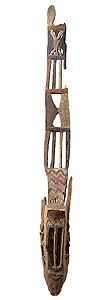
|
|
| 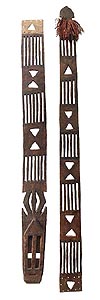
|
|
|
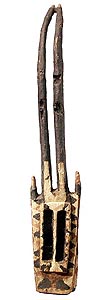
|
|
|

|
|
|

|
|
|

|
|
|

|
|
|

|
|
|

|
|
|

|
|
|  |
Valnta
ΜΕΛΟΣ "Forums ESOTERICA"
Vietnam
2285 Μηνύματα |
 Απεστάλη: 04/11/2005, 17:11:57 Απεστάλη: 04/11/2005, 17:11:57



Satimbe masks are surmounted by a female figure which represents the elder sister of the mask. 
|
|
|

|
|
| 
|
|
| 
|
|
| 
|
|
| 
|
|
| 
|
|
| 
|
|
| 
|
|
| 
|
|
|
Edited by - Valnta on 04/11/2005 17:32:51 |
Valnta
ΜΕΛΟΣ "Forums ESOTERICA"
Vietnam
2285 Μηνύματα |
 Απεστάλη: 04/11/2005, 17:23:33 Απεστάλη: 04/11/2005, 17:23:33




|
|
| 
|
|
| 
|
|
| 
|
|
| 
|
|
| 
|
|
| 
|
|
| 
|
|
|  |
Valnta
ΜΕΛΟΣ "Forums ESOTERICA"
Vietnam
2285 Μηνύματα |
 Απεστάλη: 04/11/2005, 17:27:29 Απεστάλη: 04/11/2005, 17:27:29



 |
|
|

|
|
|

|
|
|
 |
Valnta
ΜΕΛΟΣ "Forums ESOTERICA"
Vietnam
2285 Μηνύματα |
 Απεστάλη: 04/11/2005, 17:39:24 Απεστάλη: 04/11/2005, 17:39:24



----BWA PLANK MASKS, Burkina Faso-----These tall headdresses transformed the dancer into a supernatural being. They were used by the Do society at dances to promote fertility of the fields and at funerals of Do members. The geometric designs all have meanings. The checkerboard pattern symbolizes the separation of light from dark, good from evil, and female from male.

|
|
| 
|
|
|

|
|
|

|
|
|

|
|
|

|
|
|
 |
Valnta
ΜΕΛΟΣ "Forums ESOTERICA"
Vietnam
2285 Μηνύματα |
 Απεστάλη: 04/11/2005, 17:52:07 Απεστάλη: 04/11/2005, 17:52:07



----BWA SUN MASKS-----These circular masks were danced to celebrate the farming season. They represent the sun, necessary with rain and the earth for growth. The strongly abstracted patterning shows the influence of Islamic teaching over the centuries. 
|
|
| 
|
|
|

|
|
| 
|
|
|

|
|
| 
|
|
| 
|
|
| 
|
|
| 
|
|
| 
|
|
| 
|
|
| 
|
|
| 
|
|
| 
|
|
|  |
Valnta
ΜΕΛΟΣ "Forums ESOTERICA"
Vietnam
2285 Μηνύματα |
 Απεστάλη: 04/11/2005, 18:03:19 Απεστάλη: 04/11/2005, 18:03:19



----PUNU SPIRIT MASKS, Gabon-----These white-faced masks represent the spirit of an ancestor from the afterworld and were often used by stilt dancers for funeral rituals. They are known for their elegant features, forehead scarification patterns and elaborate coiffures. 
|
|
|

|
|
|

|
|
|

|
|
|

|
|
|

|
|
|

|
|
| 
|
|
|

|
|
|

|
|
|

|
|
| 
|
|
|

|
|
|

|
|
|

|
|
| 
|
|
|

|
|
|

|
|
|

|
|
|

|
|
| 
|
|
| 
|
|
|

|
|
|

|
|
|

|
|
|
 |
Valnta
ΜΕΛΟΣ "Forums ESOTERICA"
Vietnam
2285 Μηνύματα |
 Απεστάλη: 04/11/2005, 18:13:59 Απεστάλη: 04/11/2005, 18:13:59



----KWELE MASKS, Gabon-----Kwele masks are controlled by the Bwete association, which maintains social order. They are used in ceremonies to promote well-being and community. Some did not have eye slits and were shown to onlookers rather than worn. The horn motifs echo the heart shaped face, The masks are considered to be among the most beautiful in African art. 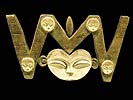
|
|
|

|
|
| 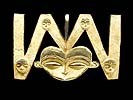
|
|
| 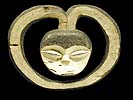
|
|
| 
|
|
|

|
|
|
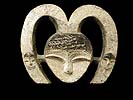
|
|
| 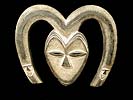
|
|
| 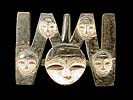
|
|
| 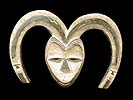
|
|
|  |
Valnta
ΜΕΛΟΣ "Forums ESOTERICA"
Vietnam
2285 Μηνύματα |
 Απεστάλη: 04/11/2005, 18:18:00 Απεστάλη: 04/11/2005, 18:18:00



----KWELE MASKS, Gabon-----Kwele masks are controlled by the Bwete association, which maintains social order. They are used in ceremonies to promote well-being and community. Some did not have eye slits and were shown to onlookers rather than worn. The horn motifs echo the heart shaped face, The masks are considered to be among the most beautiful in African art. 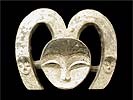
|
|
|
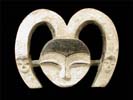
|
|
| 
|
|
| 
|
|
| 
|
|
|

|
|
|

|
|
| 
|
|
| 
|
|
| 
|
|
| 
|
|
|

|
|
| 
|
|
| 
|
|
|
 |
Valnta
ΜΕΛΟΣ "Forums ESOTERICA"
Vietnam
2285 Μηνύματα |
 Απεστάλη: 04/11/2005, 18:42:29 Απεστάλη: 04/11/2005, 18:42:29



----EJAGHAM ( EKOI ) HEADDRESSES, Nigeria-----In the southeastern forest region of Nigeria, the Ejagham (Ekoi) people live in a politically decentralized group of small, scattered villages with with several clans united under the leadership of a priest/chief (Ntoon). A Ntoon is responsible for the ritual activities of the community while the political functions are performed by various societies of elders and age-grade associations of young men. The important art forms of the Ejagham people are connected with the institution of the Ntoon and with the men's and women 's associations. The best known of these art forms are the large, skin-covered headdresses (crest masks) and the most distinctive of these elaborate sculptures are the realistic female headdress topped with curled "horns" representing elegant hairstyles. Crest masks are attached to basketry caps worn on the top of the head and were made by an artist who carved the form from a single piece of wood and covered it with soft, untanned antelope skin that had been soaked in water for several days. He stretched and tacked the skin into place until it dried and stiffened. Eyes, scarifications, and hair were often carved separately and pegged into the finished piece. Before being worn, the headdress was painted or colored, then adorned with metal pieces, wooden pegs, real hair, porcupine quills, feathers, or feathered rods stuck into holes at the top. The headdress would have been secured on the wearer's head by a string under the chin, with the body covered entirely by a long gown. These might have been worn by a woman in the context of an Ejagham women's society called Ekpa, which was responsible for the education of the girls in preparation for marriage. The headdress could represent a girl that evokes ideal female beauty and is ready for marriage. The depicted hairstyle was worn during the coming-out ceremony following the girls' seclusion.

|
|
| 
|
|
| 
|
|
| 
|
|
| 
|
|
|
 |
Valnta
ΜΕΛΟΣ "Forums ESOTERICA"
Vietnam
2285 Μηνύματα |
 Απεστάλη: 04/11/2005, 18:52:27 Απεστάλη: 04/11/2005, 18:52:27



----EJAGHAM ( EKOI) JANUS HEADDRESSES, Nigeria-----The opposing sides of janiform masks (either crest masks or helmet masks) represent male and female faces. The male side was normally stained a dark color while portaions of the female side were left the natural lighter color of the antelope skin.

|
|
| 
|
|
| 
|
|
| 
|
|
| 
|
|
| 
|
|
|

|
|
| 
|
|
|

|
|
| 
|
|
| 
|
|
|
The Art of the African Mask
*
*
About African Masks
*
*
The many faces of Africa
*
*
Masks and Secret Societies
*
*
The Mask—A West African Ceremonial Object
Edited by - Valnta on 04/11/2005 19:23:41
|
Valnta
ΜΕΛΟΣ "Forums ESOTERICA"
Vietnam
2285 Μηνύματα |
 Απεστάλη: 07/11/2005, 16:36:26 Απεστάλη: 07/11/2005, 16:36:26



--Pwo mask/ Chowke people, Congo--- 
This mask was collected by a professor from Berkley sometime between 1950-1969, before the war in Angola. Style suggests an origin in the DRC with Mbgani influence. The head covering is woven bark cloth and the hood is the traditional crocheted fabric. Usually these were worn on the forehead, with the dancer looking through the weave. The name of this mask means "young woman." It represents a female ancestor who died at a young age, and thus is a reminder of the theme of death which is part of the initiation experience of death and rebirth. The shape of the face is that of a deceased person, with sunken eye sockets and gaunt face. The tears carved under the eyes express the painful experience of loss. The filed teeth and decorative scarifications reproduce the appearance of initiated young women. |
|
|
--Hyena mask/ Baule people, Ivory Coast---

One of the oldest entertainments in Baule country is a masked dance variously called Gbagba, Ambomon or Adjemble. The performance includes masks portraying many human and animal characters from everyday life. It is performed by costumed young men or boys who mimic hunting and eventually "kill" the masked person and carry him off in triumph. This skit provides some lessons in hunting and gives young people an opportunity to parody their elders in a typically African method of social control. |
|
|
--Classic Lega Mask/ Lega people, Eastern Zaire (Congo)---

Mask of this style were originally used by association members to symbolize the attainment of higher levels of ethical teaching. Today they are one of the most common African masks. |
|
| --Chikunza mask/ Chokwe people, Angola/Zambia--- 
It is probably the most distinctive of the many makishi masks used by Chokwe people. The makishis all represent ancestor spirits and are associated with human fertility, abundance of natural resources and prosperity. This mask performs at male initiation ceremonies on behalf of the initiates and the village that hosts the initiation. |
|
|
--Sande Society mask / Mende people, Sierra Leone---

The Sande secret society guides girls in their transition to womanhood. This is the only important mask-wearing tradition in Africa exclusively for women. In fact, masks are hardly ever worn by women anywhere in the world. They are frequently called Sowei or Bundu masks. These masks, which embody Sowo, the guardian water spirit, are made to fit over the head. They usually include an elaborate hairstyle in an attempt to represent feminine beauty, with high foreheads, small, compressed facial features, and voluminous neck-rings, depicting the desirable full-figured woman. It is worn by Society members during initiation and other important ceremonies. Originally many had a dark raffia collar and were worn with a full, dark costume of raffia and cloth. |
|
|
--Gu mask/ Guro people, Ivory Coast---

A fowl eating a worm or small snake is occasionally seen on Guro masks. The three welts on the forehead symbolize the female sex. Used for agricultural ceremonies and other public festivals. |
|
|
--Mandien mask/ Kran people, Ivory Coast---

This is a "Masque Mandien" from the village of Tiobly, near the town of Taulepleu on the Liberian border. The mask is known as a joker or prankster and is a favorite of young people. The Kran are a Dan sub-group, of Cote d Ivoire and Liberia, and are closely related to the We tribe. |
|
|
 |
Valnta
ΜΕΛΟΣ "Forums ESOTERICA"
Vietnam
2285 Μηνύματα |
 Απεστάλη: 07/11/2005, 17:28:16 Απεστάλη: 07/11/2005, 17:28:16



--Chi Wara mask/ Bamana people, Mali--- 
More a headdress than a mask, these figures were worn on the head by dancers celebrating agricultural ceremonies. They allude to the antelope, which was an attribute of the mythic founder of the tribe who taught them agriculture. The dances incorporate leaping movements suggestive of the antelope. This is one is a male. The open, zigzag pattern in the neck symbolizes the sun's path along the horizon between the two solstices. Female versions are as important. They often have a small figure on the back representing a mother and child. Male and female dance together in the ceremonies. |
|
|
--Zamble (antelope) mask/ Guro people, Ivory Coast---

Can be spelled "Zamle." One of the three popular Yu masks which include the Gu and Zauli masks as well. Zambles represent the bushbuck. They were once use for social control, but are now employed primarily for entertainment. |
|
|
--Mens association mask/ Lega people, Eastern Zaire (Congo)---

Mask of this style were originally used by association members to symbolize the attainment of higher levels of ethical teaching. |
|
| --Gu mask/ Guro people, Ivory Coast--- 
Gu is a family cult. The mask is kept by a family member who is obliged to perform special duties and observe certain taboos. During the ceremonies the mask is not necessarily worn by its owner, but by a family member who is an exceptionally good dancer. |
|
|
--Nyindu mask/ Nyindu people, Eastern Congo---

The Nyindu are another of the little-known tribes found in the Ituri rainforest. As with most art objects from this region, design and craftsmanship tend to be rough. |
|
|
--Chewa mask/ Chewa people, Malawi---


The Chewa, part of the Maravi peoples, use their masks for Nyau Society performances at initiations, funerals, and other important events. The Nyau characters consists of over 100 different masks, and is constantly changing, since it often incorporates modern themes into its long tradition. The characters often involve reverse role-playing and the masks can be humorous in nature. Because the society is secret, it was banned by the British.
|
|
|
--Pwo Mask/ Luvale people, Angola or Western Zambia---

Lovale art is largely based on that of the Chokwe, but includes a more refined use of full, round shapes. This mask represents the ideal young female beauty, Mwano Pwo, and is danced by males during initiation ceremonies and other important occasions to bring fertility and prosperity to the village. |
|
| --Pig mask/ Chowke people, Angola--- 
Called Ngulu, the pig mask is danced at initiation ceremonies and represents the domestic pig. The mask is danced in an exaggerated manner along the ground or standing up, imitating the crude behavior of the animal. It makes its appearance at initiation ceremonies and other important celebrations. |
|
| --Nyanga (antelope) mask/ Bobo people, Burkina Fasso--- 
An important group whose masks are especially artistic, the Bobo people live in Eastern Burkina Faso. They are one of the tribes who speak the Gur language and are collectively known as the Gurunzi. The Bobo carve masks to symbolize animals or spirits of the bush, which are worn during ceremonies associated with a new crop, initiations and funerals. When danced the mask is attached to a black or red dyed grass costume that extends from the neck downward, cover the dancer's body to his feet. |
|
| --Kple kple mask/ Baule people, Ivory Coast--- 
This is an excellent representation of the famous kple kple mask, which is part of the Goli group of supernatural characters widely danced throughout the Baule culture. This one is a male. Females have a reddish background instead of black. |
|
|
 |
|
|
|
|
ESOTERICA.gr Forums !
|
© 2010-11 ESOTERICA.gr
|
 |
|
|
